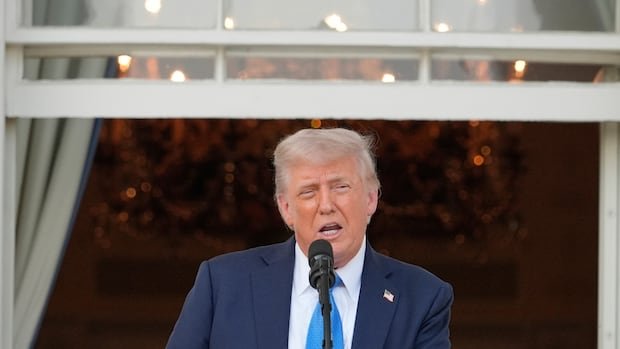U.S. President Donald Trump resurrected a hallmark policy of his first term, announcing that citizens of 12 countries would be banned from visiting the United States and those from seven others would face restrictions.
The ban takes effect Monday at 12:01 a.m., a cushion that avoids the chaos that unfolded at airports nationwide when a similar measure took effect with virtually no notice in 2017. Trump, who signalled plans for a new ban upon taking office in January, appears to be on firmer ground this time after the Supreme Court sided with him.
Some, but not all, 12 countries also appeared on the list of banned countries in Trump’s first term. The new ban includes Afghanistan, Myanmar, Chad, the Republic of Congo, Equatorial Guinea, Eritrea, Haiti, Iran, Libya, Somalia, Sudan and Yemen.
There will be heightened restrictions on visitors from Burundi, Cuba, Laos, Sierra Leone, Togo, Turkmenistan and Venezuela.
In a video released on social media, Trump tied the new ban to Sunday’s attack in Boulder, Colo., saying it underscored the dangers posed by some visitors who overstay visas. The suspect in the attack is from Egypt, a country that is not on Trump’s restricted list. The U.S. Department of Homeland Security says the suspect overstayed a tourist visa.
Trump criticizes other countries’ screening
Trump said some countries had “deficient” screening and vetting or have historically refused to take back their own citizens. His findings rely extensively on an annual Homeland Security report of visa overstays of tourists, business visitors and students who arrive by air and sea, singling out countries with high percentages of remaining after their visas expired.
“I must act to protect the national security and national interest of the United States and its people,” Trump said in his proclamation.
Haiti, which avoided a travel ban in Trump’s first term, was included for high overstay rates and large numbers who came to the U.S. illegally, the report said. Haitians continue to flee poverty, hunger and political instability deepens while police and a UN-backed mission fight a surge in gang violence, with armed men controlling at least 85 per cent of its capital, Port-au-Prince.
“Haiti lacks a central authority with sufficient availability and dissemination of law enforcement information necessary to ensure its nationals do not undermine the national security of the United States,” Trump wrote.
The list results from a Jan. 20 executive order Trump issued requiring the federal departments of State and Homeland Security and the U.S. Director of National Intelligence to compile a report on “hostile attitudes” toward the U.S. and whether entry from certain countries represented a national security risk.
Echoes of prior ban in 1st Trump term
During his first term, Trump issued an executive order in January 2017 banning travel to the U.S. by citizens of seven predominantly Muslim countries: Iraq, Syria, Iran, Sudan, Libya, Somalia and Yemen.
Front Burner24:26Are you worried about U.S. travel?
For many Canadians, travel to the United States is a yearly routine. But that’s started to change.
People around the world have shared stories about travel to the U.S. gone wrong. Some have been pulled into the back rooms of airports for additional screening, others have been pressured to share their social media accounts for examination and in the worst case scenarios, detained.
Now, out of fear or even national pride, many travelers are rethinking their travel plans. In March, nearly 900,000 fewer Canadians visited the U.S. So, what might you encounter if you choose to head down south? Is there reason to be concerned?
Today, Hannah Sampson, a travel reporter with the Washington Post, joins the show to break down the reality of traveling to the U.S. under Trump.
For transcripts of Front Burner, please visit: []
It was one of the most chaotic and confusing moments of his young, first presidency. Travellers from those nations were either barred from getting on their flights to the U.S. or detained at airports after they had landed. They included students and faculty as well as businesspeople, tourists and people visiting friends and family.
The order, often referred to as the “Muslim ban” or the “travel ban,” was retooled amid legal challenges, until a version was upheld by the U.S. Supreme Court in 2018.
The ban affected various categories of travellers and immigrants from Iran, Somalia, Yemen, Syria and Libya, plus North Koreans and some Venezuelan government officials and their families.
Trump and others have defended the initial ban on national security grounds, arguing it was aimed at protecting the country and not founded on anti-Muslim bias. However, the president had called for an explicit ban on Muslims entering the U.S. during his first campaign for the White House.

